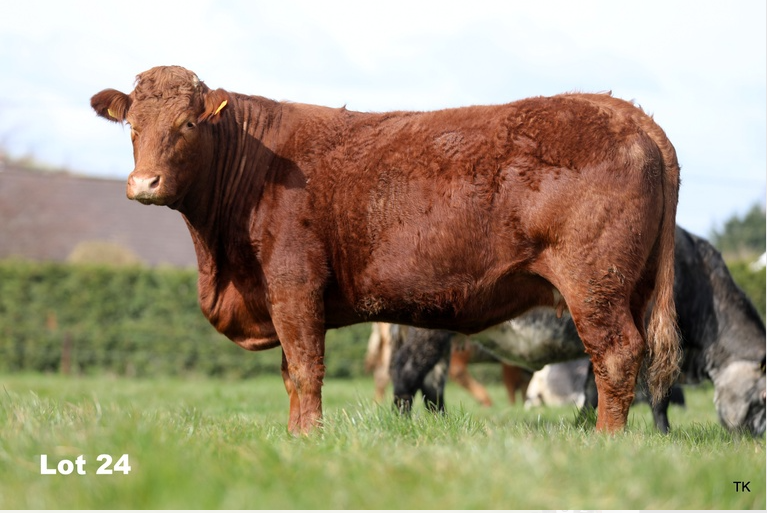For this week’s Beef Focus, Agriland paid a visit to Ireland’s largest suckler herd, based in Co. Louth.
The Tateetra and Rathmore Farms, which span across counties Louth and Meath, is managed by John Kingham.
Agriland caught up with John ahead of the farm’s special sale of 28 spring-calving suckler cows.
In-calf suckler cows
The cows are all scanned in-calf and are due to calve in April and May. John explained that the reason for the sale is the farm is moving primarily to an autumn-calving system.
John explained: “I find for my system, I have the facilities to go that road and it suits us better here.
“There’s nothing wrong with spring calving but for having the heifer sales here in the autumn, I like to have the heifers a bit stronger with a little more age to them.”

The farm calves approximately 500 suckler cows every year with a variety of breeds in use. This year, a total of 100 heifers are due to calve on the farm. All the heifers are in-calf to artificial insemination (AI) bulls.
Most of the autumn-calving takes place in October and November. Before calving, cows are housed on slats and fed a pre-calving diet of 18kg silage, 5kg chopped straw and 1.5kg pre-calver nuts.
The pre-calver nut is dear, but “the benefits greatly outweigh the costs” John said.
When cows come near calving, they are brought into a dry-bedded shed that is bedded with dry peat.

At point of calving, they go to the calving shed and after a few days, they go to group dry-bedded housing.
Some of the cow-calf pairings on the farm:



Cows and calves are then segregated into groups; heifer calves are kept together and bull calves are kept together.
They are housed for the remainder of the winter and get out to grass in early to mid-March.
Grass covers are strong on the farm currently, and John outlined: “At the minute, I have at least six weeks of grazing ahead of me. I’ll be taking out a lot of this ground for silage.”

Pit silage, round-bale silage and hay are all used on the farm. Hay is fed in the calving shed because John finds “it keeps facilities drier and elders cleaner”.
Vaccination protocols are in place on the farm and cows are vaccinated against a range of viruses.
“We vaccinate against Leptospirosis, Infectious Bovine Rhinotracheitis (IBR), Bovine Viral Diarrhoea (BVD), Roto-Corona, Salmonella and a range of others as well,” said John.
John believes that placing greater emphasis on heard health over recent years has helped improve AI conception rates.
He added: “This year has been my best AI hit ever. We do batches of thirty and we’re getting over 80% in-calf to AI. We only use AI once and then go with stockbulls afterwards.”
A sample of the spring-calving sucklers on offer at the sale:






John has strong views on the suckler sector and is hugely passionate about the suckler enterprise and seeing smaller suckler farms succeeding and prospering.
“The small suckler farmers are the cornerstone of rural Ireland. There has been too much negative talk about the viability of small-scale sucker farmers,” he said.
“Farmers who have poor cows should look at replacing them with good cows that will produce a quality weanling.”

“In the suckler business, quality is always going to be key,” he stressed.
“You don’t need stars to breed good cattle, you know yourself what cows have plenty of milk, and you know if you put a good bull on that cow, she is going to have a good calf.
“I know a lot of five-star cows that wouldn’t give you as good of a calf as a one-star cow.
“I never looked once at the stars of any of these cows and I don’t buy bulls on stars either. I have two eyes and I look at the beast and that’s how I judge if it’s a decent one or not.”
John believes the star-rating system is more beneficial to dairy-bred progeny than it is to suckler-bred progeny and says: “There was no thought put into it.”
He believes grass management is key to success on both small and large suckler farms.
“Farmers who have, say it’s 25ac, they need to be thinking ‘grass, grass, grass’ and how can they get more out of it,” John said.

“Look at getting more paddocks, drinkers and trying to use more grass,” he continued.
“By tightening your grass management up, it could allow a farmer to have an extra cow or two in their field and that means an extra weanling or two for selling in the autumn.
“A small farm will never make you millions but if you have 20 of the best suckler cows and you do them as best as you can and get €1,200 – €1,300 for every one of them weanlings, it’s a nice lift. Keep thinking quality.”
Concluding, John noted that while plainer cattle are making good money currently, “the top quality weanling will always make the top-quality price”.
The sale will take place on Friday, April 15, at 6:00p.m and viewing is open to all interested buyers before the sale.
Potential buyers who are interested in viewing the cows before the sale can contact John on: 087 167 4960, to arrange a viewing before the day of the sale.
The sale will be online-bidding only through the MartEye app and will be run in conjunction with Thurles Mart.
